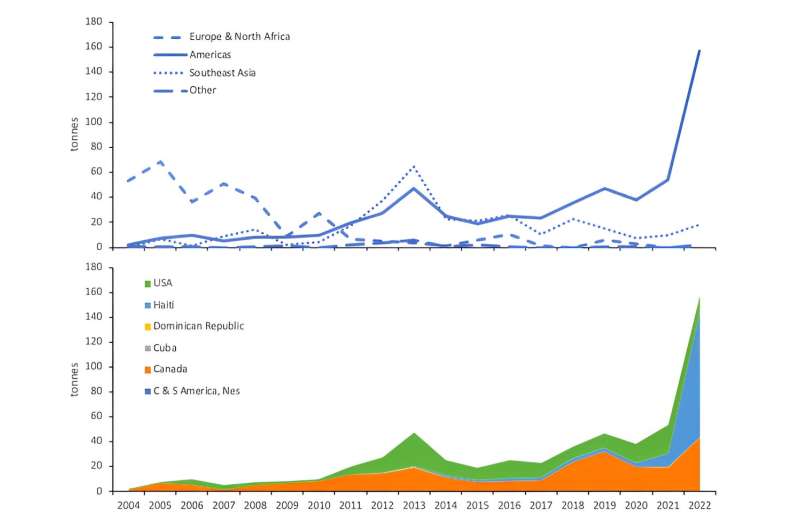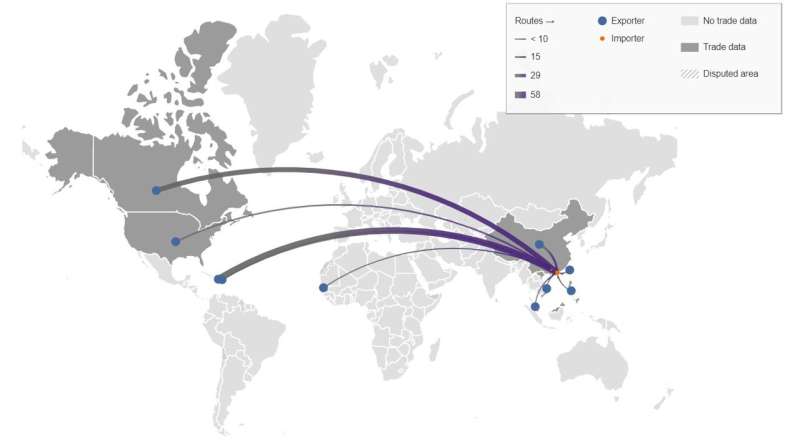This article has been reviewed according to Science X's editorial process and policies. Editors have highlighted the following attributes while ensuring the content's credibility:
fact-checked
peer-reviewed publication
trusted source
proofread
American Eel as an emerging consumer target

Research led by Hiromi Shiraishi, a researcher at Chuo University, indicated a steep rise in the importation of American Eel (Anguilla rostrata) live fry to East Asia for aquaculture purposes. This surge poses a potential threat to the already endangered species, further depleting the resources of this species.
"Early warning of an upsurge in international trade in the American Eel," has been published in Marine Policy.
Japan relies on imports for two-thirds of its eel consumption and it is believed that a significant quantity of American Eel is included in these imports. As a major consumer of eels, Japan is urged to take a leading role in ensuring the sustainable utilization of eel species, including the American Eel.
There are currently 19 species/subspecies of freshwater eels in the genus Anguilla. Eels are susceptible to a range of threats including changes in oceanic currents and/or climatic conditions, barriers to migration, loss or degradation of freshwater habitat, disease, pollution, and unsustainable exploitation and trade.
Stocks of eel species most notably those in temperate Northern Hemisphere regions, have exhibited declines. These include the European Eel, currently listed as Critically Endangered (CR) on the IUCN Red List of Threatened Species, as well as the Japanese Eel and American Eel, which are classified as Endangered (EN).
As artificial breeding of Anguilla spp. is not yet commercially viable, most of consumed eels originate from wild eel fry (glass eels) that are captured and then farmed. Live eel fry have become targets for capture in many countries as essential 'seed' in farming/aquaculture operations. Eel farming predominantly occurs in East Asia (China, Japan, South Korea and Taiwan), with Hong Kong being an important trade hub.
With the European Eel being listed CITES Appendix II in 2007, which came into effect in 2009, and the low catches of Japanese eels in the early 2010s, fishing and trade of live fry of other eel species has increased. Imports from the Americas into East Asia remain high while Haiti and the Dominican Republic seem to have become key exporters of live eel fry recently.
Customs import data for Anguilla live eel fry for the East Asian countries and territories provide an overview of trade dynamics of live eel fry imported into the region. As species-specific Customs data are not available, geographic origin and the IUCN Red List were used to infer the likely eel species being traded and supplied to farms conducted (e.g., assuming imports from Canada to be American Eel).
It is noted that while all East Asian countries/territories have import codes for live eel fry for aquaculture, the definitions vary, potentially including larger size of eel fry in the data.
The analysis showed that imports of live eel fry from the Americas to East Asia (likely to be American Eel) surged from 2 tonnes in 2004 to 157 tonnes in 2022. The average imports from the Americas from 2009 to 2021 was 29.1 ± 14.3 tonnes, so the imports in 2022 were more than five times the mean.

In 2022, imports from the Americas accounted for 89% of all live eel fry imports into East Asia, with Hong Kong being the primary importer (accounting for 96%). Hong Kong reportedly imported 100.6 tonnes of live eel fry from Haiti, 43.4 tonnes from Canada, 12.7 tonnes from the US, and 0.2 tonnes from the Dominican Republic in 2022. Almost all eels exported from Haiti were traded via Canada and the US.
Compared to trade volume of other eel species, illegal trade in European eels is ongoing even after the CITES listing of the species (from 2009) and ban on exports and imports from/into the EU (from 2010). EUROPOL estimated that up to 100 tonnes were smuggled during the 2017–2018 fishing season.
The annual input of Japanese eels for aquaculture in East Asia has been less than 100 tonnes since the 2011–2012 fishing season. Compared to these figures, the 157-tonnes import is striking and suggests that the American Eel is presently the most extensively exploited eel species in the world.
The high demand for American Eels has led to illegal, unreported, and unregulated (IUU) fishing, illegal trade, and social disputes in some species-range states. In Canada, aside from seizures of fry and arrests of violators, conflicts about fishing quotas between fishers and Indigenous people have been reported. Some portion reportedly enters the black market in countries such as the Dominican Republic and Haiti.
Prompt intervention is required to prevent further depletion of the American Eel, which is listed as Endangered on the IUCN Red List. The extent and scale of glass eel harvest and export from the Caribbean are still relatively unknown as fisheries and/or trade data are not fully available. The American Eel may reach a similar situation as the European Eel in the 1990s to the early 2000s, which led to the CITES listing of the species in 2007.
Meanwhile, in East Asian farming countries/territories which has driven the demand for live eel fry, the nonbinding 'Joint Statement' has been developed since 2014 relating to 'International Cooperation for Conservation and Management of Japanese Eel Stock and Other Relevant Eel Species.'
It encourages East Asian countries/territories to take every possible measures not to increase the amount of initial input of seeds of non-Japanese eel from the levels in the 2014 season. Inputs for non-Japanese eels were 39.9 t in total in the 2013–2014 fishing season (China 32 t, Japan 3.5 t, South Korea 2.9 t, Taiwan 1.5 t).
If the import figure of 157 tonnes is accurate, it substantially exceeds this limit. These data are not fully comparable as import data might include larger size of eel fry than glass eels or eels that died during transportation; so evaluation of the accuracy of the input reports are required to better understand the levels of import. Co-operation between range states, transit and import countries/territories also would be essential to better understand the scale of exploitation and trade and how to address any IUU activity.
As the boom in exploitation and export may also occur for other eel species anytime, monitoring and management targeting the whole genus Anguilla genus are essential to achieve sustainable use and conservation of the species.
This research demonstrates the rapid increase in the utilization of American Eel live eel fry for aquaculture in East Asia. However, even in consuming nations, awareness of consuming American Eel is largely absent.
In Japan, the lack of species-specific codes in customs statistics and the fact that processed products (such as kabayaki) might be attributed to the processing location, which could be different from the country of origin, makes it unclear how much American Eel is being consumed. As a major consumer of eels, Japan is urged to play a more leading role in achieving sustainable utilization of anguillid eels, including American Eel.
More information: Hiromi Shiraishi et al, Early warning of an upsurge in international trade in the American Eel, Marine Policy (2023). DOI: 10.1016/j.marpol.2023.105938
Journal information: Marine Policy
Provided by Chuo University



















